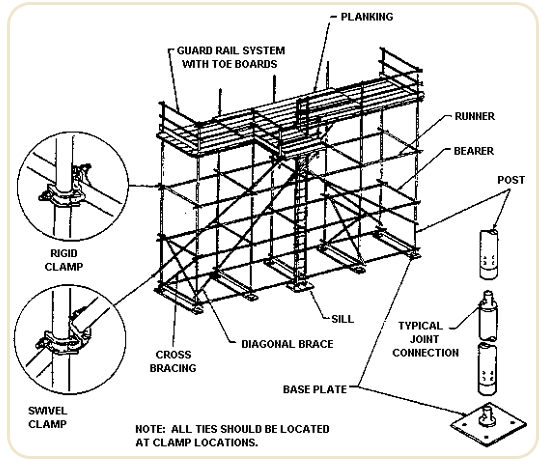Quality Scaffolding Surrey for Both Residential and Commercial Projects
Quality Scaffolding Surrey for Both Residential and Commercial Projects
Blog Article
A Comprehensive Overview to the Vital Functions of Scaffolding in Modern Building And Construction
The landscape of contemporary building progressively relies upon reliable scaffolding systems that focus on safety, performance, and advancement. As projects expand in intricacy, understanding the crucial functions of scaffolding comes to be essential for making certain worker security and maximizing project timelines. This guide explores different types of scaffolding, highlights vital safety functions, and examines material advancements that contribute to efficiency and sustainability. However, the ramifications of these components prolong far beyond simple construction methods, prompting a more detailed take a look at just how they affect total task success and worker wellness.
Types of Scaffolding
Although scaffolding systems can differ extensively in style and application, they generally fall under numerous distinct categories that provide to different construction needs - Scaffolding. One of the most usual kinds consist of supported scaffolding, put on hold scaffolding, and rolling scaffolding
Sustained scaffolding contains systems sustained by a framework of posts, which offer a elevated and secure functioning surface. This type is commonly made use of for tasks that require substantial elevation, such as bricklaying or outside paint.
Suspended scaffolding, conversely, is used for tasks requiring accessibility to high altitudes, such as cleaning or repairing structure exteriors. This system hangs from an additional structure or a rooftop, enabling employees to lower or elevate the platform as needed.
Rolling scaffolding attributes wheels that enable very easy movement across a task site. It is particularly beneficial for jobs that call for frequent relocation, such as indoor work in large areas.
Each kind of scaffolding is made with certain applications in mind, making certain that building and construction jobs can be performed effectively and properly. Recognizing these categories is important for choosing the appropriate scaffolding system to fulfill both project requirements and site conditions.
Secret Security Functions
Security is vital in scaffolding systems, as the potential risks connected with operating at heights can cause significant accidents if not correctly managed. Key security functions are important to make certain the health of employees and the integrity of the building site.
Firstly, guardrails are essential. These barriers provide a physical safeguard against drops, dramatically lowering the threat of serious injuries. In addition, toe boards are often made use of to stop tools and materials from dropping off the scaffold, securing workers below.
One more important component is making use of non-slip surfaces on platforms. This function enhances grasp, specifically in unfavorable climate condition, consequently lessening the likelihood of slides and falls. Furthermore, accessibility ladders must be securely positioned to promote risk-free access and departure from the scaffold.
Regular evaluations and upkeep of scaffolding systems are additionally important. These inspections make certain that all components are in excellent condition and working correctly, attending to any wear or damage quickly.
Last but not least, proper training for all employees involved in scaffolding procedures is important to make certain that they understand security methods and can recognize possible risks. Scaffolding. Collectively, these attributes develop a safer working environment and substantially minimize risks associated with scaffolding
Material Technologies
Innovations in material science have significantly affected the scaffolding industry, boosting both safety and security and performance in modern-day building and construction. The intro of high-strength steel and aluminum alloys has revolutionized traditional scaffolding systems.
Additionally, ingenious composite products, such as fiberglass-reinforced plastics, have become sensible options. These products are resistant to deterioration and environmental degradation, thus extending the lifespan of scaffolding systems, particularly in harsh climate conditions. Using such materials adds to decrease upkeep expenses and guarantees consistent performance gradually.


Design Considerations
Considering the complexities of contemporary construction jobs, effective scaffolding design is critical to making certain both functionality and safety and security. Layout factors to consider have to incorporate different elements, consisting of lots capacity, elevation, and the certain needs of the building website. Each job provides unique obstacles, requiring a versatile approach to scaffolding systems that can adapt to varying conditions.
Structural honesty is essential; for that reason, designers need to compute the loads that the scaffolding will certainly sustain, including workers, products, and equipment. The selection of materials plays a vital duty in ensuring the scaffolding can hold up against these loads while remaining long lasting and lightweight. Furthermore, the style should enable simple gain access to and egress, promoting the smooth activity of personnel and products.
Security features, such as guardrails and non-slip surfaces, should be incorporated to reduce dangers of mishaps. In addition, the design has to consider the surrounding setting, including prospective dangers and surrounding structures. By resolving these design factors to consider, building and construction firms can boost the effectiveness of scaffolding systems and promote a safer working environment, ultimately adding to the general success of the project.
Upkeep and Inspections
The efficiency of scaffolding systems expands past initial style and execution; continuous upkeep and routine inspections are important to guaranteeing their proceeded performance and security throughout the period of a task. Regular evaluations should be carried out by qualified personnel to determine any indicators of wear, damages, click resources or instability that can jeopardize the honesty of the scaffolding.
Upkeep protocols should consist of regular checks of architectural components, such as structures, fittings, and planks, guaranteeing that all elements stay secure and free from rust or other wear and tear. In addition, the capability of security functions, such as guardrails and toe boards, must be examined to guarantee conformity with safety and security laws.
Documentation of all evaluations and maintenance activities is essential for responsibility and regulative compliance. An organized technique to record-keeping not only help in tracking the condition of the scaffolding however additionally supplies necessary evidence in case of an event.
Ultimately, establishing a comprehensive upkeep and evaluation routine will dramatically go to this web-site minimize the risk of accidents and improve the overall safety of the building website. By prioritizing these methods, construction supervisors can safeguard workers and promote the task's stability.

Verdict
In conclusion, the necessary functions of scaffolding in contemporary building encompass a series of vital elements, including diverse types, essential safety and Web Site security systems, product technologies, and thoughtful design considerations. Stressing safety and security with guardrails and non-slip surface areas, alongside innovations in materials like high-strength steel, boosts both performance and sustainability. In addition, routine upkeep and assessments are important for making certain architectural integrity and safety on building websites, inevitably facilitating reliable project execution and promoting the health of employees.
The landscape of modern-day building progressively depends on reliable scaffolding systems that prioritize safety and security, development, and effectiveness.Improvements in product scientific research have significantly affected the scaffolding market, enhancing both safety and security and performance in contemporary building and construction. Generally, these product developments not only improve the efficiency and security of scaffolding systems but likewise align with the industry's push towards sustainability, as lots of contemporary products are created to be more ecologically pleasant.
Taking into consideration the intricacies of modern-day construction jobs, efficient scaffolding layout is vital to ensuring both capability and safety.In final thought, the vital features of scaffolding in modern building incorporate a variety of important aspects, including varied kinds, essential safety and security systems, material advancements, and thoughtful layout factors to consider.
Report this page